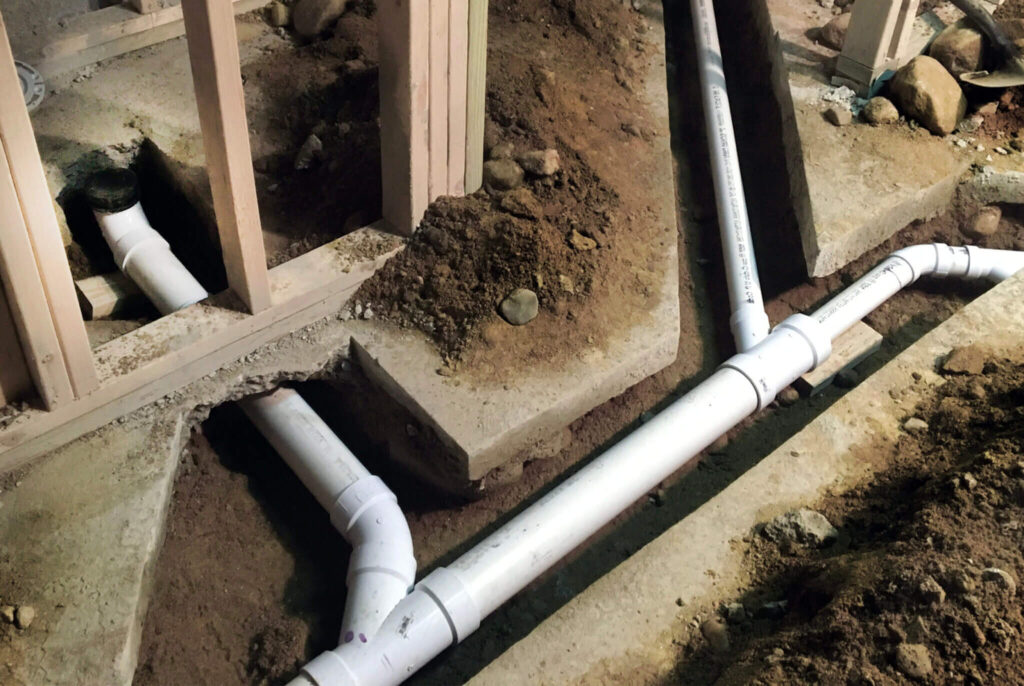
Drains
Get Plumbing Services Now
Key components of a drainage system include:

Drain Pipes
These are the pipes that carry wastewater away from fixtures and appliances. They are typically made of materials such as PVC, ABS, or cast iron.

Traps
Traps are U-shaped pipe fittings installed beneath sinks, showers, and other fixtures to prevent sewer gases from entering the building while allowing wastewater to flow through.

Vent Pipes
Vent pipes allow air to enter the drainage system, preventing suction that could slow down or stop the flow of wastewater. They also help to vent sewer gases safely outside the building.

Cleanouts
Cleanouts are access points in the drainage system that allow plumbers to inspect and clear blockages or clogs.

Drainage Fixtures
These are the various sinks, toilets, showers, and other fixtures that connect to the drainage system.
A drainage system works like this:
- Water Goes Down: When you use sinks, toilets, showers, or appliances like washing machines, the dirty water goes down pipes in your home.
Gravity Helps: These pipes are tilted slightly so that water and waste can flow down easily because of gravity.
- Trap Stops Smells: Before the water goes into the pipes, it passes through a bend in the pipe called a trap. This trap holds some water to block bad smells from coming back up into your home.
- Air Goes Out: There are pipes that go up from your drainage system to the roof. These pipes let air in and out to keep everything flowing smoothly and to stop any air from getting stuck.
Water Leaves: Eventually, the dirty water leaves your home and goes to a treatment plant or a septic tank, where it’s cleaned up before being released back into the environment.
Keep it Clean: To keep everything working well, it’s important to check your drainage system regularly, keep it clean, and fix any leaks or blockages quickly. And remember not to flush things down the toilet that can clog the pipes!
Get Plumbing Services Now
The most common drainage system issues include:
- Clogs: One of the most frequent problems is clogging, caused by the buildup of debris, grease, hair, soap scum, or foreign objects in the pipes. Clogs can lead to slow draining, backups, and unpleasant odors.
Leaks: Leaks can occur due to corrosion, damaged pipes, loose connections, or faulty seals. Leaking pipes can cause water damage to walls, floors, and ceilings, as well as contribute to mold growth and structural problems.
Root Intrusion: Tree roots seeking moisture can infiltrate drainage pipes through cracks or joints, causing blockages and pipe damage. Root intrusion often requires professional intervention to remove the roots and repair the pipes.
Sagging or Bellied Pipes: Over time, drainage pipes may develop sags or bellies, where sections of the pipe slope downward instead of maintaining the proper gradient. This can lead to standing water, slow drainage, and potential blockages.
Corrosion: Corrosion, especially in older metal pipes, can weaken the pipe walls and lead to leaks, rust buildup, and eventual pipe failure. Corrosion may be caused by chemical reactions, high acidity or alkalinity in the water, or exposure to corrosive substances.
Frozen Pipes: In cold climates, drainage pipes located in unheated areas or exposed to frigid temperatures may freeze and burst, causing extensive damage and requiring immediate repair.
- Poor Installation: Improper installation of drainage pipes, incorrect slope, inadequate support, or using inferior materials can result in various problems, including leaks, clogs, and inefficient drainage.
- Septic Tank Issues: For properties with septic systems, common problems include tank overflow, drain field saturation, sewage backups, and the need for routine maintenance such as pumping and inspection.
- Inadequate Ventilation: Blocked or insufficient vent pipes can lead to airlock, causing slow drainage, gurgling noises, and foul odors within the plumbing system.
- Fixture Problems: Malfunctioning or improperly installed plumbing fixtures, such as toilets, sinks, or showers, can contribute to drainage issues such as clogs, leaks, or improper drainage flow.
The drainage system is a crucial component of a building’s plumbing infrastructure, ensuring proper sanitation and preventing the buildup of wastewater within the building. Proper design, installation, and maintenance of the drainage system are essential to avoid plumbing problems such as backups, leaks, and foul odors.
Our All Services
- Boilers and Heating Systems
- Commercial Plumbing Solutions
- Drains
- Emergency Plumbing Services
- Faucet and Sink Services
- Garbage Disposals
- Gas Line Services
- Leak Detection
- Outdoor Plumbing Solutions
- Piping & Re-piping
- Plumbing Repairs
- Sewer Services
- Showers & Toilets
- Water Heaters
- Water Line Maintenance
- Water Treatment Systems
+1 (888) 695-0243
Contact the Call Now Plumbing to schedule a service call.
Be prepared to provide help about the problem.
Don't let a plumbing emergency disrupt your life.
Call Now Plumbing to resolve your plumbing crisis with professionalism and care.